- Books Name
- ACME SMART COACHING Biology Book
- Publication
- ACME SMART PUBLICATION
- Course
- CBSE Class 11
- Subject
- Biology
PHYLUM: CNIDARIA (Coelenterata
- The phylum Cnidaria (the old name is Coelenterata) includes about 9,000 species, mainly marine. They are sessile, free swimming, radially symmetrical invertebrates and more complex than sponges
- General characters of this phylum are as follows:
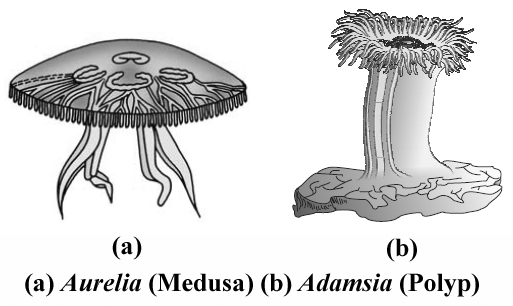
1. Cnidarians exhibit a blind sac body plan and are radially symmetric. They are more advanced than sponges in having true tissues. They are, however, acoelomate.
2. Body wall consists of only two cell layers, the ectoderm and the endoderm, separated by a jelly-like mesoglea. These animals are therefore diploblastic, that is, arising from two embryonic cell layers.
Concept Builder
Body wall in coelenterates (with reference to Hydra).
They are diploblastic animals i.e., they are derived from two layers-ectoderm and endoderm. These germ layers form the epidermis and gastrodermis.
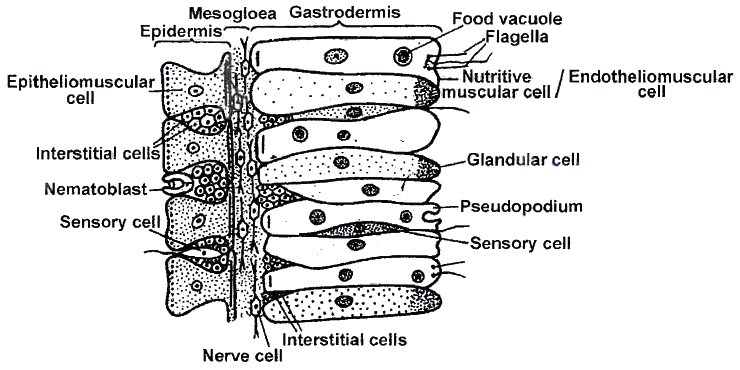
(1) Epidermis: The various epidermal cells are:
(a) Epithelio-muscular cells: Each cell has two functional parts, the outer epithelial part, extending to the body surface and the basal muscular part drawn out into two muscle processes along the longitudinal axis of the body. The muscle processes contain a contractile fibril myoneme.
(b) Glandulo-muscular cells : The epithelio-muscle cells, chiefly in the region of the pedal disc, are especially modified to secrete sticky material for attachment of animal to substratum.
(c) Interstitial cells: They are totipotent cells which give rise to all the different cells of the body.
(d) Sensory cells: They are scattered throughout the epidermis. They are most numerous on the tentacles, hypostome and basal disc. They receive and transmit impulses.
(e) Nerve cells: They occur for the first time in coelentrates. They are present at the base of epithelio-muscle cells. They conduct impulses in all the directions.
(f) Germ cells : They remain in restricted regions. They proliferate to form gonads. They are ectodermal in hydrozoa and endodermal in Scyphozoa and Anthozoa.
(g) Cnidoblasts : Many of the interstitial cells of the epidermis become specialized to form the stinging cells, called the cnidoblasts. They migrate to the tentacles through the mesoglea by means of amoeboid movements. Projecting cnidoblasts act as organs for offence and defence.
Structure:
- The cytoplasm of a cnidoblast contains a conspicuous nucleus lying to one side, and a peculiar oval or pyriform sac filled with a poisonous fluid, hypnotoxin. The sac is a part of stinging apparatus, known as the nematocyst (stinging structure).
Occurence of nematocysts :
- The nematocysts occur scattered mostly singly, throughout the epidermis of the body but remain absent on the basal disc.
- They are abundant in the epidermis of the oral region and the tentacles where they cluster as wart-like "nematocyst batteries".
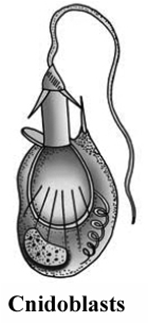
Difference between four nematocyst

(2) Gastrodermis: It is the inner layer of the body. The cells are of following types :
(a) Endothelio-muscle or nutritive muscle cells : They help in contraction of the body and nutrition.
(b) Endothelio-gland cells : They secrete digestive enzymes in coelenteron. In the region of hypostome and mouth are found mucous gland cells. Gland cells are absent in the tentacles and basal disc.
(c) It also contains interstitial cells, sensory cells and nerve cells but no cnidoblasts.
(3) They enclose gastrovascular cavity (coelenteron), having single opening hypostome. Their digestion is intra and extracellular.
Concept Builder
1. The green colour of Chlorohydra viridissima comes from alga Chlorella vulgaris (Zoochlorella), that lives inside the gastrodermal cells of Hydra in symbiotic relationship.
2. Corallium rubrum (red coral) has been used widely in jewellery and known as red moonga.
HYDRA

- Some important characters of Hydra are :
(i) Hydra flourishes well in cool, clean and stagnant water.
(ii) Number of tentacles surrounding mouth in Hydra is 6-10. Tentacles of Hydra are hollow while that of obelia are solid.
(iii) Food of Hydra is water fleas (Daphnia and Cyclops). Thus, it is carnivorous. It cannot digest starch.
(iv) No free larval stage in development of Hydra. Hence, development is direct.
(v) Most species of Hydra are dioecious/unisexual.
(vi) Male Hydra bears 1-8 conical testes towards distal end whereas female Hydra bears 1-2 rounded ovaries towards proximal end of the body.
(viii) Locomotion in Hydra occurs by looping, somersaulting, gliding, walking and floating etc.
METAGENESIS AND POLYMORPHISM
- Colenentrata members shows polymorphism most common is polyp & medusa forms.
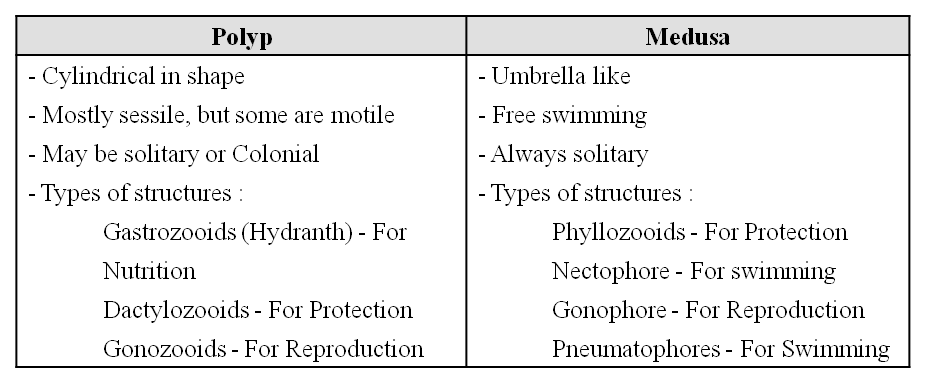
- In the life-cycle there is an alternation of the asexual polyp phase and the sexual medusa phase and it is termed as Metagenesis.
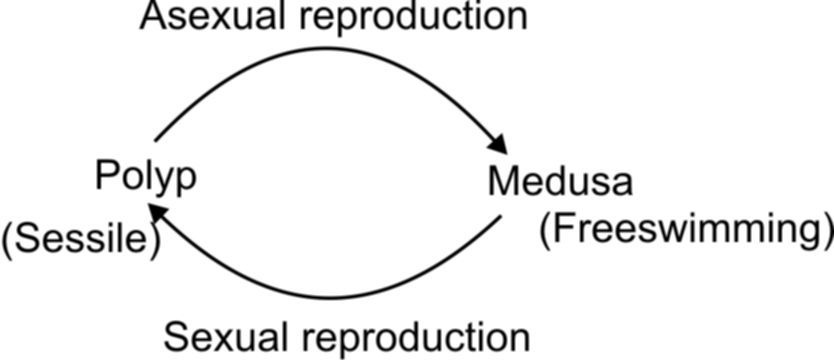
- During sexual reproduction, medusae liberate gametes into water. Following fertilization, the zygote forms a ciliated larva called Planula, which swims, settles and grows into a sessile polyp. (Some cnidarians, like Hydra, do not have a medusa stage. Hydra has no larval form, no metagenesis).
- Polyps reproduce asexually by budding where as, medusa liberates gametes into water during 'Sexual reproduction. Both asexual and sexual forms are free living.
CLASSIFICATION
Chiefly on the basis of the dominance of medusoid or polypoid phase in the life cycle, the phylum Cnidaria is divided into three classes

Concept Builder
Coral Reefs :
- A coral reef is a ridge or mound in a shallow, tropical sea, has its upper surface near the surface of water, supports a variety of animals and plants. It is formed of calcium carbonate produced by some of its inhabitant, chiefly medreporarian corals. Coral reefs form stable marine ecosystems. The coral reefs are of three kinds :
(i) Fringing Reefs : The coral reefs lying close to the shores of some volcanic island or part of some continent are called the fringing reefs. Hawaiian is lands are an ideal example of permanent fringing reefs.
(ii) Barrier Reefs : They are like the fringing reefs but are located some distance from the shore. The stretch of water of lagoon separates the barrier reefs from land. Australia's Great Barrier Reef is an example of such a reef which is about 900 nautical miles long and 90 miles from sea shore.
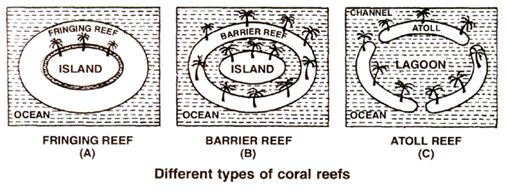
(iii) Atoll reefs : An atoll reef is also called coral island or lagoon island which is a circular or horse shoe shaped reef that encircles a lagoon but not an island. It may be complete or broken by a number of channels of which only a few are navigable. The Lakshadweep and Maldive islands in the Indian Ocean are composed of Atoll reef.
Phylum Coelenterata
They are also known by the name Cnidaria. They are radially symmetrical aquatic, primarily marine, sessile, or free-swimming organisms. Typically, these are invertebrate species with a very basic tissue arrangement. Coelenterates can be found in colonies or alone. Coelenterates are the simplest animal group with genuine tissues and the coelenteron or gastrovascular cavity as a distinguishing feature. The word Cnidaria comes from the stinging capsules or nematocysts found on the tentacles and body, which are called Cnidoblasts or Cnidocytes. Cnidoblasts are the phylum Cnidaria's distinguishing trait.They contain stinging capsules called nematocysts. It aids in both prey capture and defence. Cnidoblasts are employed for prey capture, defence, and anchoring. Cnidarians are diploblastic and have tissue-level organization. They have a single aperture in the center of their gastro-vascular cavity, and their mouth is hypostome. Extracellular and intracellular digestion are both involved.The skeleton of some cnidarians, such as corals, is made of calcium carbonate. Polyp and medusa are the two primary body types of cnidarians. The former, like Hydra, Adamsia, and others, are sessile and cylindrical, whereas the latter, like Aurelia or jellyfish, is umbrella-shaped and free-swimming. Cnidarians often show alternation of generations (Metagenesis). When both polyps and medusae exist within a Cnidarian life cycle, polyps reproduce asexually by budding off medusae, and medusae form the polyps sexually (e.g. Obelia). Examples: Physalia (Portuguese man-of-war), Adamsia (Sea anemone), Pennatula (Sea-pen), Gorgonia (Sea-fan), and Meandrina (Brain coral).
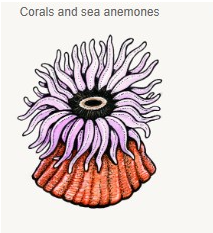
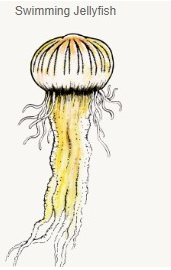
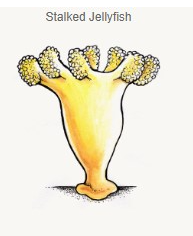
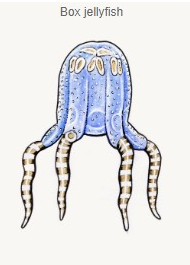
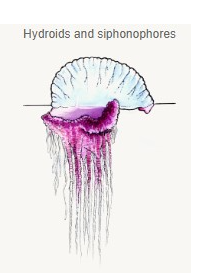
Figure 6: Phylum Cnidaria.

 ACME SMART PUBLICATION
ACME SMART PUBLICATION
